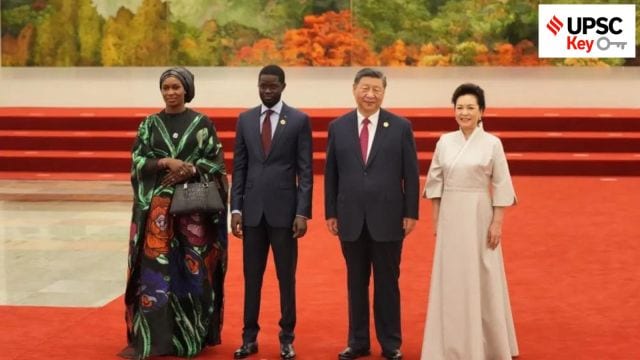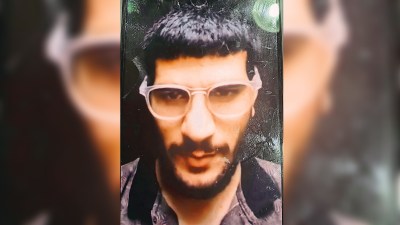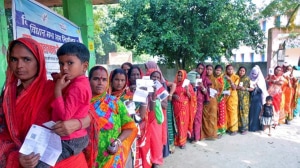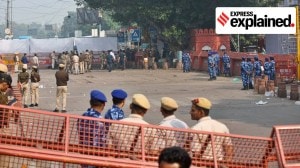🚨 The Indian Express UPSC Essentials brings to you the August edition of its monthly magazine. Click Here to read. Share your views and suggestions in the comment box or at manas.srivastava@indianexpress.com🚨
Story continues below this ad
The World
China stops short of Africa debt relief as it pledges more cash in credit
UPSC Syllabus:
Preliminary Examination: Current events of national and international importance
Mains Examination: GS-II: Bilateral, regional and global groupings and agreements.
What’s the ongoing story- China stopped short of providing the debt relief sought by many African countries this week, but pledged 360 billion yuan ($50.7 billion) over three years in credit lines and investments.
Prerequisites:
— What is the Forum for China-Africa Cooperation (FOCAC)?
— Read about the Belt and Road Initiative.
Key takeaways:
— The Forum for China-Africa Cooperation (FOCAC) launched in 2000 took on an enhanced role after the 2013 inception of President Xi Jinping’s Belt and Road Initiative (BRI), which aims to recreate the ancient Silk Road for the world’s second-largest economy and biggest bilateral lender to Africa.
Story continues below this ad
— China has also sought to use FOCAC to counter growing competition in Africa from the United States, the European Union, Japan and others.
— The new financial pledge is more than what Beijing promised at the last FOCAC in 2021, but below the $60 billion of 2015 and 2018, which marked the peak of lending to Africa under the Belt and Road Initiative.
For Your Information:
— The Forum on China-Africa Cooperation was established in 2000 to formalise the strategic partnership between China and African nations. A summit is conducted every three years, with the host alternating between China and an African member.
— The FOCAC counts 53 African nations as its members – the entire continent except Eswatini, which has diplomatic ties with Taiwan against Beijing’s “One China” Policy. The African Union Commission, the continental bloc tasked with ensuring cooperation and economic integration across its member countries, is also a member.
Story continues below this ad
— The theme of this year’s FOCAC summit is “Joining Hands to Advance Modernization and Build a High-Level China-Africa Community with a Shared Future.”
— The last FOCAC summit was held virtually in Beijing and Dakar, Senegal in 2021, owing to Covid-19 restrictions. Commitments to continued economic and political cooperation were made.
Points to Ponder:
— What is the history of India’s relationship with Africa?
— What is the significance of Africa for India?
— What are the challenges faced by India with China’s growing dominance in Africa?
Story continues below this ad
— What initiatives have been taken to strengthen India’s ties with Africa?
Post Read Question:
Prelims
(1) Which among the following countries is not member of the Forum on China-Africa Cooperation?
(a) Botswana
(b) Eswatini
(c) Gabon
(d) Malawi
Mains
Increasing interest of India in Africa has its pro and cons. Critically Examine. (UPSC CSE 2015)
Other Important Articles Covering the same topic:
Explained: Significance of the China-hosted FOCAC summit, with 53 African countries in attendance
Story continues below this ad
To find how much carbon it holds, Amazon is being surveyed like never before
UPSC Syllabus:
Preliminary Examination: Current events of international importance and Environment
Mains Examination: GS-I, GS-III: Geography, Environment, Conservation, environmental pollution and degradation, environmental impact assessment.
What’s the ongoing story- The study is part of a new, multimillion-dollar effort in dozens of patches of forest across the world that’s aimed at figuring out, to an unprecedented degree of precision, the extent to which forests perform an epic service to humanity by capturing and locking away huge amounts of carbon dioxide, the main planet-warming greenhouse gas.
Prerequisites:
— Read about the Amazon forests.
— What is a carbon sink?
— What are the different types of forests?
Key takeaways:
— Tropical forest and other land absorbs one-third of all the world’s planet-warming carbon dioxide emissions. The Amazon, despite its immensity, is actually particularly fragile. This year, fires in the Brazilian Amazon hit a 14-year high. The whole region was bathed in smoke.
Story continues below this ad
— Scientists have been warning for years that the Amazon is nearing a tipping point where it shifts from capturing carbon dioxide to being a net emitter of it. As it shrinks, it becomes less able to pull water from the ocean and sustain its lushness (which, in a climate-system way of thinking, is also its ability to store carbon).
For Your Information:
— The Amazon forests in South America are the largest tropical forests in the world.
— The Amazon basin is huge with an area covering over 6 million square kilometres, it is nearly twice the size of India. The Amazon rainforests cover about 80 per cent of the basin and as per NASA’s Earth observatory, they are home to nearly a fifth of the world’s land species and is also home to about 30 million people including hundreds of indigenous groups and several isolated tribes.
— Other than this, the basin produces about 20 per cent of the world’s flow of freshwater into the oceans. Over the last few years, the forest has been under threat due to deforestation and burning.
Points to Ponder:
— What is the significance of Amazon forests?
— How does deforestation impact Amazon’s carbon storage capacity?
Story continues below this ad
— What steps have been taken to address various challenges faced by Amazon forests?
Post Read Question:
(2) Which of the following countries are covered under the Amazon rainforests?
1. Brazil
2. Venezuela
3. Peru
4. Argentina
5. French Guiana
Select the correct answer using the codes given below:
(a) 1, 2 and 3 only
(b) 1, 3, 4 and 5 only
(c) 1, 4 and 5 only
(d) 1, 2, 3 and 5 only
Other Important Articles Covering the same topic:
Explained: Why the Amazon forests are no longer acting as a carbon sink
Front Page
UPSC Syllabus:
Preliminary Examination: Current events of national and international significance
Story continues below this ad
Mains Examination: GS-II, III: India and its neighbourhood- relations, Internal Security
What’s the ongoing story- In a first, Pakistan Army chief General Asim Munir has publicly acknowledged the role of the country’s military in the 1999 Kargil conflict with India.
Prerequisites:
— Read about the Kargil war.
— What is Kargil Vijay Diwas?
— What is the history of India-Pakistan bilateral relations?
Key takeaways:
— Addressing an event at the General Headquarters in Rawalpindi Friday to mark Pakistan’s 59th Defence Day, General Munir, referring to Pakistan’s wars with India, said, “Be it 1948, 1965, 1971, the Pak-India war in Kargil or the Siachen battlefront, thousands of Shuhada (martyrs) have sacrificed their lives for the nation and Islam.”
— He also referred to the Kashmir issue as a global problem, stating that peace in South Asia can be established with its solution.
— This is the first time that a serving Pakistan Army chief has admitted to the country’s military’s involvement in the 1999 Kargil conflict, references to which have been avoided in official communication in Pakistan.
— India marked 25 years of Kargil Vijay Diwas on July 26 this year.
For Your Information:
— Kargil Vijay Diwas, celebrated every year, is a significant day in the history of India. It is observed to pay tribute to the bravery of Indian soldiers who sacrificed their lives for the country during the Kargil War of 1999.
— The infiltration was discovered in May 1999, prompting the Indian Army to launch Operation Vijay and leading to the Kargil War. This conflict occurred between India and Pakistan in the Kargil district of Kashmir and along the Line of Control (LOC) from May to July 1999.
— Over two months, intense battles took place in the difficult mountainous terrain. The Indian Army managed to drive out Pakistani intruders and successfully recaptured Tiger Hill and other strategic positions as part of Operation Vijay.
— The Indian soldiers secured this victory after a three-month conflict on July 26, 1999. However, the war resulted in casualties on both sides, with the Indian forces losing nearly 490 officers, soldiers, and jawans
Points to Ponder:
— What are the internal security concerns on border areas with Pakistan?
— What is the status of the India-Pakistan Relationship?
— What was the recommendation of the Kargil Review Committee?
Post Read Question:
(3) With reference to Kargil War, consider the following statements:
1. After the end of the war, Henderson Brooks – Bhagat Report was released having an in-depth analysis of the war.
2. Operation Vijay was the result of two months of rigorous shelling on the steep hills of Kargil ridge.
3. During the Kargil War, the Indian Army was at a particular disadvantage with the enemy occupying high positions overlooking the positions held by Indians.
How many of the statement/s given above is/are correct?
(a) Only one
(b) Only two
(c) All three
(d) None
Other Important Articles Covering the same topic:
Kargil Vijay Diwas: How the Indian Army conquered the unkind conditions of Kargil
Govt & Politics
UPSC Syllabus:
Preliminary Examination: Indian Polity, Governance and Social Development
Mains Examination: GS-II: Government policies and interventions for development in various sectors
What’s the ongoing story- After Punjab, the AAP government in Delhi has also relented under financial pressure and agreed to sign a Memorandum of Understanding (MoU) with the Centre to implement the Pradhan Mantri Schools for Rising India (PM-SHRI) scheme in the Capital.
Prerequisites:
— What is the Pradhan Mantri Schools for Rising India (PM-SHRI) scheme?
— Know about the Samagra Shiksha Abhiyan (SSA).
— What are the constitutional provisions related to education?
— Read about the National Education Policy (NEP) 2020.
Key takeaways:
— The PM-SHRI scheme, with a budget of over `27,000 crore for the next five years — the Centre is supposed to shoulder 60% of the financial burden and the states 40% — aims to upgrade at least 14,500 government schools into “exemplar” institutions to showcase the implementation of the National Education Policy (NEP) 2020. States must confirm their participation by signing a Memorandum of Understanding (MoU) with the Education Ministry.
— Five states — Tamil Nadu, Kerala, Delhi, Punjab and West Bengal — are yet to sign the MoU. While Tamil Nadu and Kerala have indicated their willingness, Delhi, Punjab and West Bengal had earlier refused, ostensibly prompting the Centre to stop their SSA funds.
— The SSA is funded in a 60:40 ratio by the Centre and the States. SSA funds cover salaries for a section of teachers and staff, help provide uniforms and textbooks to students in government schools along with support for differently abled children, and reimbursement to private schools for admission of children belonging to the economically weaker section and disadvantaged groups category.
For Your Information:
— Approved in 2022, the PM Shri scheme is for existing elementary, secondary, and senior secondary schools run by the central government and state and local governments around the country.
— A centrally sponsored scheme is one in which the cost of implementation is mostly split in a 60:40 ratio between the Union government and the states/UTs. The mid-day meal scheme (now PM Poshan) or the PM Awas Yojana are examples of centrally sponsored schemes.
Points to Ponder:
— What are the issues and concerns associated with the PM-SHRI scheme?
— What are the benefits of the PM-SHRI scheme?
— What are the challenges of the education system in India?
— What initiative has been taken by the government with regard to improving the education system in India?
Post Read Question:
Discuss the main objectives of Population Education and point out the measures to achieve them in India in detail. (UPSC CSE 2021)
Other Important Articles Covering the same topic:
What is PM SHRI, the ‘showcase’ schools scheme that Centre is pushing in states?
Economy
UPSC Syllabus:
Preliminary Examination: Current events of national importance and economic development
Mains Examination: GS-III: Indian economy
What’s the ongoing story- The banking sector has been struggling with slower growth in deposits compared to credit over the past few months. Latest data from the Reserve Bank of India (RBI) showed that while deposits grew at 11.7 per cent in the quarter ending in June 2024, bank credit rose at 15 per cent.
Prerequisites:
— What do you understand by asset-liability mismatch?
— What is the capital market?
— Read about the RBI.
Key takeaways:
— As the gap increases between deposits (which customers keep with the bank and get interest for) and credit (which the bank lends to customers at an interest rate charged from them), it creates an asset-liability mismatch for lenders.
— The widening gap has concerned the government and the RBI, who have asked lenders to focus more on deposit mobilisation through innovative products.
— The outflow of household savings from banks to capital markets is one of the major reasons for a slower growth in deposits in the banking system.
— After the Covid-19 pandemic, the Indian capital markets have seen a surge in retail activity through direct (direct trading) and indirect (using mutual fund route) channels. Higher returns, robust digital infrastructure which has eased the investment process and rapid smartphone penetration have facilitated the entry of more retail investors into capital markets.
Points to Ponder:
— Why is slowing deposit mobilisation a matter of concern?
— What efforts have been taken to tackle the challenge of slow deposit mobilisation?
— What are the issues and challenges faced by the Indian Banking Sector?
Post Read Question:
Prelims
(4) Consider the following statements:
Statement 1: The banking sector has been struggling with slower growth in deposits compared to credit.
Statement 2: As the gap increases between deposits and credit, it creates an asset-liability mismatch for lenders.
Which one of the following is correct in respect of the above statements?
(a) Both Statement 1 and Statement 2 are correct and Statement 2 is the correct explanation for Statement 1.
(b) Both Statement 1 and Statement 2 are correct and Statement 2 is not the correct explanation for Statement 1.
(c) Statement 1 is correct but Statement 2 is incorrect.
(d) Statement 1 is incorrect but Statement 2 is correct.
Mains
What steps need to be taken to educate investors about the risks and benefits associated with the capital market?
Other Important Articles Covering the same topic:
Why the gap between bank credit and deposits is worrying
Express Network
UPSC Syllabus:
Preliminary Examination: Environment
Mains Examination: GS-III: Environment
What’s the ongoing story- About 85 per cent of India’s districts are exposed to extreme climate events while 45 per cent are witnessing a “swapping” trend, where districts once prone to floods are now facing droughts and vice versa, a study released on Friday found.
Prerequisites:
— What are extreme climate events?
— What are the reasons behind the extreme weather events?
Key takeaways:
— The study, by IPE Global and Esri India, also mapped the extreme climate events between 1973 and 2023 and found that the frequency, intensity and unpredictability of these climate extremes have increased fourfold in recent decades.
— The study suggests that more than 1.47 billion people will be at risk owing to extreme climate events by 2036 and that a hyper-granular risk assessment is necessary to protect the country’s economic interests and sensitive sectors such as agriculture, industry and large-scale infrastructure.
— In terms of the kind of extreme events, eastern districts were found to be more flood-prone, closely followed by the north-eastern and southern zones of India, the study said. “More than 90 per cent districts of Assam, 87 per cent districts in Bihar, 75 per cent districts in Odisha and 93 per cent districts in Andhra Pradesh and Telangana are exposed to extreme floods,” the study stated.
— The study also found that over the last decade, there has been a fivefold increase in cyclone events in the western districts and an overall 1.5-fold rise in such events.
— The geospatial and climatological analysis offered evidence of the swapping trend where districts prone to one kind of extreme climate event are experiencing the exact opposite extreme event.
For Your Information:
— The average global temperature on Earth has increased by at least 1.1 degree Celsius since 1850, primarily due to human activities that have released unprecedented levels of greenhouse gases into the atmosphere.
— The spike in the temperatures has resulted in more frequent and more intense extreme weather events across the world. These events include heat waves, droughts, floods, hurricanes, and wildfires.
Points to Ponder:
— How do extreme weather events and disasters impact the critical infrastructure?
— What measures have been taken globally and nationally to tackle the issue of climate change?
— What measures can be taken to mitigate the effects of climate change?
Post Read Question:
Examine the implications of climate change on India’s critical infrastructure. Discuss the measures needed to enhance resilience in the face of these challenges.
Other Important Articles Covering the same topic:
Warming up to climate change
The Sunday Express Magazine “eye”
UPSC Syllabus:
Preliminary Examination: Current events of national importance. (Health)
Mains Examination: GS II, GS-III: Issues relating to development and management of Social Sector/Services relating to Health, Education, Human Resources; Science
What’s the ongoing story- Using mobile phones, no matter how long, is not linked to brain and head cancers, according to a comprehensive review of the highest quality evidence commissioned by the World Health Organization (WHO). The researchers found no increase in risk for cancers such as glioma and salivary gland tumours despite years of mobile use among subjects.
Prerequisites:
— What is cancer?
— What are the primary causes of cancer?
— Know about the brain cancer.
— Organisation to look for: World Health Organization (WHO)
Key takeaways:
— The review is significant as for years many myths had been swirling around about the side effects of wireless technology devices like mobile phones emitting radio-frequency electromagnetic radiation, also known as radio waves. In fact, the WHO’s International Agency for Research on Cancer (IARC) had designated radio frequency and electromagnetic fields as a possible carcinogen in 2011.
— When the IARC termed radio-frequency and electromagnetic field as possibly carcinogenic in 2011, it was largely based on positive associations seen in case-control studies (studies that look at the difference in incidence of cancers in groups using and not using cell phone), which might have been biased based on what the participants recalled, the current analysis said.
— Not only did the review find no overall association between mobile phone use and cancer, it overruled any risk with prolonged use (for those using their mobile phones for 10 years or more) and frequency (the number of calls made or the time spent per call).
For Your Information:
— Cancer is a broad term encompassing a group of diseases characterized by uncontrolled cell growth. These abnormal cells, unlike healthy ones, ignore signals to stop dividing and can form tumors. They can also invade surrounding tissues and spread (metastasize) to other parts of the body, causing significant damage.
— The root cause of cancer lies in mutations within a cell’s DNA. These mutations can be inherited or occur due to environmental factors like exposure to carcinogens (cancer-causing agents) such as tobacco smoke, radiation, and certain chemicals.
Points to Ponder:
— Why are cancer cases rising in India? Why is early awareness and detection important?
— What is CAR-T cell therapy?
— What are the key highlights of the Global Burden of Cancer released by WHO?
— What are some of the cutting-edge technologies that have revolutionised cancer care in India?
— What are some major government initiatives in India to tackle cancer?
Post Read Question:
(5) With reference to the cervical cancer, consider the following statements:
1. It is caused by the Human Papilloma Virus (HPV).
2. It is the second most prevalent common cancer in India.
3. Cervavac is the first indigenous vaccine against cervical cancer.
How many of the statements given above are correct?
(a) Only one
(b) Only two
(c) All three
(d) None
Other Important Articles Covering the same topic:
Why are cancer cases soaring in India?


































